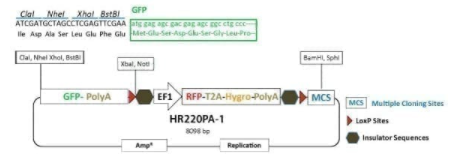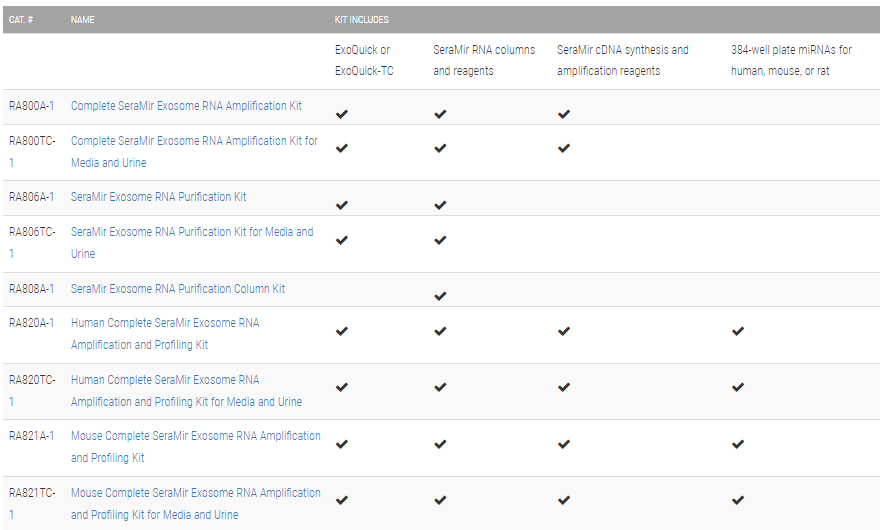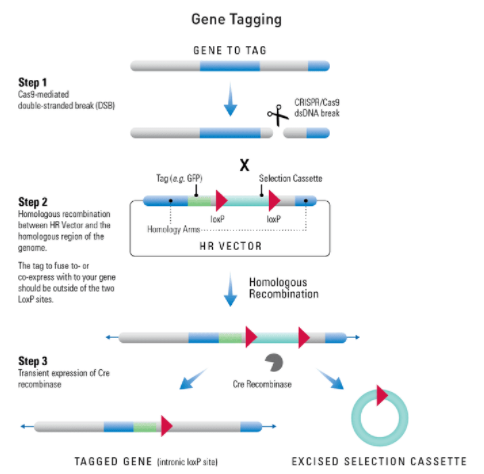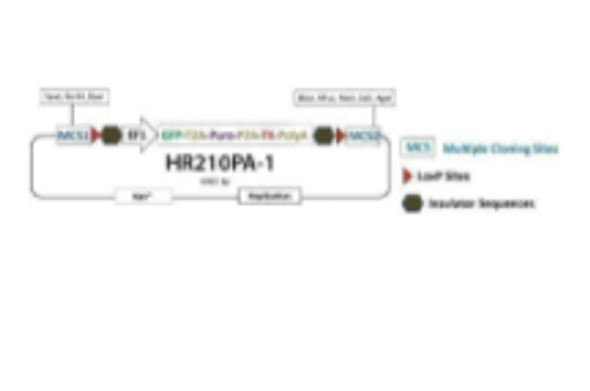System Biosciences
GFP-Fusion HR Targeting Vector [GFP-pA-LoxP-EF1a-RFP-T2A-Hygro-pA-LoxP-MCS]
- SKU:
- HR220PA-1
- Availability:
- Usually Shipped in 5 Working Days
- Size:
- 10 ug
- Shipping Temperature:
- Blue Ice/ Dry Ice
Description
GFP-Fusion HR Targeting Vector [GFP-pA-LoxP-EF1a-RFP-T2A-Hygro-pA-LoxP-MCS]. Cat# HR220PA. Supplier: SBI System Biosciences

Overview
Use the PrecisionX™ Gene Tagging HR Targeting Vector (GFP-pA-LoxP-EF1α-RFP-T2A-Hygro-pA-LoxP-MCS) to fuse GFP to any gene in the genome. Clone your homology arms into the two MCSs and use hygromycin selection and RFP-positive imaging to find integrants. After you’ve identified clones with your GFP-tagged gene, you can remove the selection cassette using the Cre-LoxP system (learn more about Cre-LoxP excision here).



How It Works
At-a-glance—how to use an HR Targeting Vector to tag a gene

Figure 1. Tagging a gene using an HR Targeting Vector. Step 1: Cas9 creates a double-stranded break (DSB) in the genomic DNA at a site that is complimentary to the gRNA. Step 2: The DNA repair machinery is recruited to the DSB. In the presence of an HR Donor with homology to the region adjacent to the DSB (blue areas of the genomic and vector DNA) homologous recombination (HR) is favored over non-homologous end joining (NHEJ). The tag you’d like to fuse to a gene should lie outside of the two LoxP sites. Result: The HR event leads to insertion of the region of the HR Donor Vector between the two homology arms—your tag ends up fused your gene-of-interest and your selection cassette is integrated. To remove the selection cassette (leaving behind the tag and a single LoxP site), transiently express Cre recombinase.
Genome engineering with CRISPR/Cas9
For general guidance on using CRISPR/Cas9 technology for genome engineering, including the design of HR Targeting Vectors, take a look at our CRISPR/Cas9 tutorials as well as the following application notes:
CRISPR/Cas9 Gene Knock-Out Application Note (PDF) »
CRISPR/Cas9 Gene Editing Application Note (PDF) »
CRISPR/Cas9 Gene Tagging Application Note (PDF) »

![GFP-Fusion HR Targeting Vector [GFP-pA-LoxP-EF1a-RFP-T2A-Hygro-pA-LoxP-MCS] GFP-Fusion HR Targeting Vector [GFP-pA-LoxP-EF1a-RFP-T2A-Hygro-pA-LoxP-MCS]](https://cdn11.bigcommerce.com/s-i3n9sxgjum/images/stencil/608x608/products/12678/12943/sbi%2520system%2520biosciences_1633075021__00205.original__31669.1633076565.jpg?c=1)
![GFP-Fusion HR Targeting Vector [GFP-pA-LoxP-EF1a-RFP-T2A-Hygro-pA-LoxP-MCS] GFP-Fusion HR Targeting Vector [GFP-pA-LoxP-EF1a-RFP-T2A-Hygro-pA-LoxP-MCS]](https://cdn11.bigcommerce.com/s-i3n9sxgjum/images/stencil/608x608/products/12678/12943/sbi%20system%20biosciences_1633075021__00205.original__31669.1633076565.jpg?c=1)
![GFP-Fusion HR Targeting Vector [GFP-pA-LoxP-EF1a-RFP-T2A-Hygro-pA-LoxP-MCS] GFP-Fusion HR Targeting Vector [GFP-pA-LoxP-EF1a-RFP-T2A-Hygro-pA-LoxP-MCS]](https://cdn11.bigcommerce.com/s-i3n9sxgjum/images/stencil/608x608/products/12678/15648/Screenshot_2021-12-09_223452__34777.1639071351.png?c=1)
![GFP-Fusion HR Targeting Vector [GFP-pA-LoxP-EF1a-RFP-T2A-Hygro-pA-LoxP-MCS] GFP-Fusion HR Targeting Vector [GFP-pA-LoxP-EF1a-RFP-T2A-Hygro-pA-LoxP-MCS]](https://cdn11.bigcommerce.com/s-i3n9sxgjum/images/stencil/100x100/products/12678/12943/sbi%20system%20biosciences_1633075021__00205.original__31669.1633076565.jpg?c=1)
![GFP-Fusion HR Targeting Vector [GFP-pA-LoxP-EF1a-RFP-T2A-Hygro-pA-LoxP-MCS] GFP-Fusion HR Targeting Vector [GFP-pA-LoxP-EF1a-RFP-T2A-Hygro-pA-LoxP-MCS]](https://cdn11.bigcommerce.com/s-i3n9sxgjum/images/stencil/100x100/products/12678/15648/Screenshot_2021-12-09_223452__34777.1639071351.png?c=1)




![GFP-T2A-Luciferase Co-Expression HR Targeting Vector [GFP-T2A-Luc-pA-loxP-EF1α-RFP-T2A-Puro-pA-LoxP-MCS] GFP-T2A-Luciferase Co-Expression HR Targeting Vector [GFP-T2A-Luc-pA-loxP-EF1α-RFP-T2A-Puro-pA-LoxP-MCS]](https://cdn11.bigcommerce.com/s-i3n9sxgjum/images/stencil/590x590/products/12680/12945/sbi%2520system%2520biosciences_1633075021__00205.original__65000.1633123753.jpg?c=1)
![GFP-T2A-Luciferase Co-Expression HR Targeting Vector [GFP-T2A-Luc-pA-loxP-EF1α-RFP-T2A-Puro-pA-LoxP-MCS] GFP-T2A-Luciferase Co-Expression HR Targeting Vector [GFP-T2A-Luc-pA-loxP-EF1α-RFP-T2A-Puro-pA-LoxP-MCS]](https://cdn11.bigcommerce.com/s-i3n9sxgjum/images/stencil/590x590/products/12680/15650/Screenshot_2021-12-09_224538__37530.1639071973.png?c=1)



